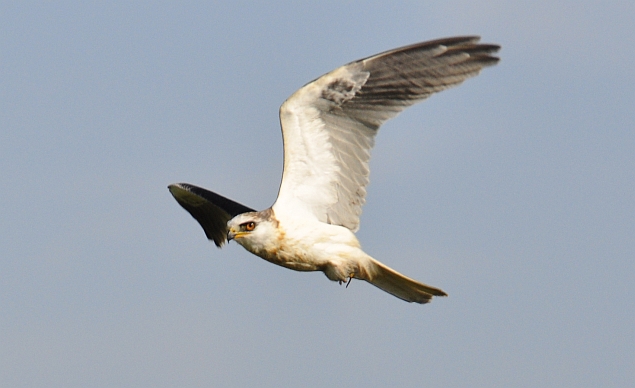White-tailed Kite. This young bird had just plummeted to earth and crushed a small rodent. Todays shots are all from my old shorebirding grounds at Point Mugu, CA, where I was lucky to bird earlier this month. It had been a long time...the birds that saturate this area helped put me on the shining path to Number 7 when I was just an awkward teenager.
Here's a closer look. You can see a couple little feet and a tail sticking out. This is a young bird, easily told by the rusty "necklace" and nape, and limited black patch under the wing. I think the eyes are a bit duller too...most birds with red eyes don't get them until they are adults.
The Point Mugu area is one of the best places in southern California for shorebirds. Pectoral Sandpipers occur in good numbers here in fall. Good numbers is an understatement actually...there is a veritable shitload of Pectoral Sandpipers. It is amazing.
This is probably one of those species that I would not be so enamored with if I lived someplace where they were common...but since I don't, I am enamored.
Juvenile Western Sandpipers bring fall with them as they migrate south. You see, they carry autumn on their rusty shoulders. Falling leaves are for suckers.
Red-necked Phalarope with a high scumline. High scumlines are in this fall.
Being a seabird at heart, phalaropes always adhere to the Economy of Style in the fall.
This Red-necked Phalarope was too close for comfort. I was terrified that I would get sucked into the circular vortex it was spinning.
Lesser Yellowlegs are another locally common shorebird here. They are drawn to the grassy impoundments like The Great Ornithologist Felonious Jive is drawn to a bottle of bourbon.
This fork-tailed kingbird gave me pause, but I was able to make sure it was a juvenile Cassin's Kingbird before we parted ways (you can just make out the gape at the base of the bill in this photo). Seeing a kingbird with a tail like this on the west coast in fall will lead you to a Tropical Kingbird more often than not, but there are lots of other field marks to look out for.
Cooper's Hawk. With so many birds packed into the area, it is no wonder that a lot of raptors call the fields and marshes home as well. It is an area that birders fantasize about to no end...the potential for MEGAS is endless.
Here is the above White-tailed Kite as it stoops toward the vole it had been eyeing. I wish getting lunch could be this fun.












Could you please write a field guide? Maybe a field guide/site guide? Please? I want to be reading a site guide to somewhere and see the words "veritable shitloads" in print.
ReplyDeleteAnything for Flycatcher Jen.
DeleteYou don't pounce on your lunch Seagull?
ReplyDeleteI agree with Jen, I would like to see "Seagull Steve's Guide to Face-Melting MEGAS and Shitloads of Shorebirds", maybe with an extended section on Enigmatic Empids and Jay Jizz? Partner this with recommended hard-alcoholic beverages to consume while pursuing the different groups (also contingent on the time of year, naturally) and you, sir, will have made a superlative field guide.
So, on your Kingbird, the breast looks very dark too, even taking the shadow into account. since it is in shadow though, for prudence's sake would you dismiss the breast color as being an applicable field-mark in this instance?
P.S. I had a White-tailed Kite poop on my car and me and almost my wife while we were honeymooning in California last summer. No big deal.
Correct on the breast. It is a good mark, but the bad light is what made this a protracted i.d. At times the breast looked particularly yellow, although not so much in this shot.
DeleteYour car got a kite baptism. Blessed be!